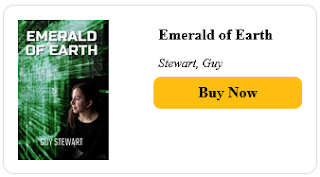We’ve been having a lot of conversations lately, about the future of Stupefying Stories in particular, the future of indie publishing in general, and the future of writing SF/F in broad and sweeping terms. Rather than try to shoehorn these conversations into our usual Q&A format, today’s column will be more of a free-ranging discussion of what we’ve talked about and decided, thus far.
For example, one conversation began with this seemingly harmless little glyph, which triggered a small panic when I shared it on Facebook. This is a QR code that you can scan with your phone. It takes you directly to Ingram, where you can buy the paperback edition of Guy Stewart’s YA novel, Emerald of Earth directly from the printer.
What?! Are we abandoning Amazon? Are we going off on yet another Quixotic quest into the wilderness of indie distribution and direct sales?
No, we’re not that masochistic. This QR code, and its dozen or so friends, exists because our friend Guy Stewart is doing a young writer’s workshop this week, in a venue affiliated with a well-respected local indie bookstore, and the bookstore wants to have printed books in-hand to sell during the workshop. At the same time, they categorically refuse to handle print-on-demand books manufactured by Amazon.
We’re sympathetic. We’ve done our last few print books through Ingram. While Amazon’s print-on-demand service is much faster and slightly cheaper, doing a book through Ingram results in a noticeably higher quality book. That, and Ingram can produce proper hardcover books, with dust jackets and the works, which is something Amazon still can’t or won’t do.
So when you buy, say, the trade paperback or hardcover of THE PRINCESS SCOUT on Amazon, what you’re actually getting is a book that was printed by Ingram, and is being resold by Amazon, the same as they would resell any other book by any major publisher. Ingram is first and foremost a book distributor.
This is a crucial point. When we do a print edition through Amazon, customers can only buy the book on Amazon. When we do a print edition through Ingram, it can be distributed anywhere—which effectively means to Amazon, Barnes & Noble, and such indie bookstores as choose to stock it.
Which brings us back to EMERALD OF EARTH. In figuring out how to set things up so that the local indie bookshop could get copies directly from Ingram, I found that Ingram has branched out into consumer-direct sales, and is now providing helpful things like the above QR code and the embeddable html code that produced the above “Buy Now” box. This should make it slightly easier to sell books to those few remaining folks who absolutely refuse to do business with Amazon.
I expect most people will still buy their books through Amazon, though, as Amazon offers FREE SHIPPING AND PRIME POINTS! while Ingram does not. It’s darned hard to beat that free shipping.
§
Please note that the foregoing discussion applies only to print books. While Ingram can distribute e-books, they don’t do it very well. Instead, for e-books, we have a two-tier strategy.
First and foremost, our e-books go directly to KDP, Amazon’s Kindle Digital Publishing operation. Here in the third decade of the 21st Century the book publishing industry is mostly on Kindle, somewhat in print, and with a very tiny share left over for all the other e-book formats that aren’t Kindle.
We used to deal directly with Apple Books and Barnes & Noble Nook. Both companies made the process so unpleasant we were happy to quit dealing with them and go back to putting out books exclusively on Kindle. If you want to know why Amazon Kindle is so dominant today, it’s because ten years ago both Apple and Barnes & Noble went out of their way to drive small-press and indie publishers away from supporting their e-readers.
Today, we use Draft2Digital to do our e-book distribution to all non-Kindle platforms. If you find one of our titles on Nook, Kobo, Smashwords, Apple Books, or any other e-book platform, Draft2Digital put it there. Draft2Digital also gives us handy tools like this:
Depending on the title you can find the links to every edition of the book, including the print and audio book editions, all in one place. Now if only they’d let us put a bit of ad copy on this web page. As it stands, there are links galore, but it’s still completely dependent on the cover art to get people interested in clicking through on any of those links.
E.g., this book: yeah, sure, there are formats and links galore. But what’s it about?
Oops. Out of time. I’ll finish this tomorrow.
~brb





















0 comments:
Post a Comment